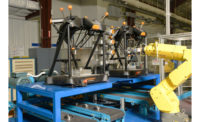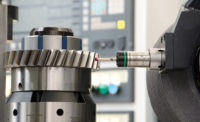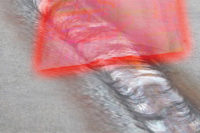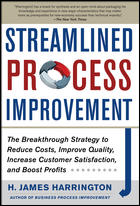So, what do we mean when we talk of post-process monitoring? Quite simply, it is the process used to monitor both the process and the finished product against their specifications, which include logging process routines and results in order to inform the machining and finalizing of the product.
Dan Skulan, General Manager - Industrial Metrology for Renishaw in the U.S., summed it up, saying, “The goal with post-process monitoring is to get quick, comprehensive feedback about the whole production process, looking at both a part and all of the elements of manufacturing in that final workpiece. It is important that this information be accurate and actionable, so we focus on increasing the speed that you can capture data without compromising accuracy.”
Traditionally, this includes anything from the use of manual, handheld gaging equipment to full function measuring systems like coordinate measurement machines (CMMs), however, it is becoming popular to include equipment not synonymous with post-process monitoring.
“There are CMM technologies, such as 5-axis multi-sensor technologies are taking off, getting used more and more, because of the sheer volume of accurate actionable information they can provide,” said Skulan. “But then again, the use of flexible gaging uses programming like a CMM but measures discreet features out on the shop floor so you can get very quick feedback into your process when you’re monitoring it.”
In addition to the equipment we use, we also have to consider the manufacturing process itself, particularly with the rise of additive manufacturing and automation.
So, how is post-process monitoring affected by additive manufacturing? To consider this, we need to dig down into the two types of additive manufacturing.
“There’s plastic additive manufacturing and metal additive manufacturing,” said Skulan. “Plastic has been used for a long time for prototyping, but direct metal printing of parts with additive manufacturing is where Renishaw specializes, not only in the measuring of the parts, but making machines that print parts. So, Renishaw is a 3D-printer manufacturer as well.
“The interesting thing is that there is a lot of hype about additive manufacturing saying that you design a part and print it and you’re done, and that’s just not the case,” continued Skulan. “The surface finish and the actual final geometries of a part coming off a metal additive-manufacturing system are typically not precision enough to be used. For the most part, there must be finish machining, so when we are talking about post-process monitoring for additive manufacturing, it actually is two different things.”
As Skulan explained, the post-process monitoring of the additive manufacturing process is also the pre-process monitoring for finished machining.
“There are processes to access the piece coming off the machine that tell you the final result of that process, but that additive manufacturing process is only part of the complete production of that part,” Skulan said. “It also includes finished machining”.
“There are technologies that can be used for both the post-process of additive manufacturing, telling you the shape, size, form, and finish of a part, and how well the additive manufacturing process was conducted, but also provide primary, fundamental data to be feed into subsequent machine operations.”
Though an interesting question, Skulan does not see the two being separated.
“Engineering companies, like Renishaw and others, constantly advance technologies to make things better, so the surface finish from the additive process can be improved, but there is probably a limit because the size of the powder that goes in is always going to leave some deformation or some inconsistency on the surface, so there is always finishing that needs to be done,” he said.
However, there are companies that are making machines that do 3D and machining in the same machine. For instance, some companies are using the same laser technology that melts the layers for 3D printing to ablate after it’s been printed. “So, yes, I do see technology moving more and more toward parts coming off the machine being ready to use, but, in most cases, there is still some type of material removal involved to get to that final product, and maybe one machine doing it all,” Skulan said.





